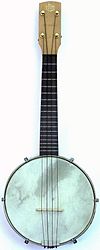The banjo is a stringed instrument with a thin membrane stretched over a frame or cavity to form a resonator. The membrane is typically circular, and usually made of plastic, or occasionally animal skin. Early forms of the instrument were fashioned by African Americans in the United States, adapted from African instruments of similar design. The banjo is frequently associated with folk and country music. Banjo can also be used in some rock songs. Many rock bands, such as The Eagles, Led Zeppelin, and The Allman Brothers, have used the five-string banjo in some of their songs. Historically, the banjo occupied a central place in African-American traditional music and the folk culture of rural whites before entering the mainstream via the minstrel shows of the 19th century. Along with the fiddle, the banjo is a mainstay of American old-time music. It is also very frequently used in traditional ("trad") jazz.

The ukulele or ukelele is a member of the lute family of instruments. It generally employs four nylon strings.

String instruments, stringed instruments, or chordophones are musical instruments that produce sound from vibrating strings when the performer plays or sounds the strings in some manner.
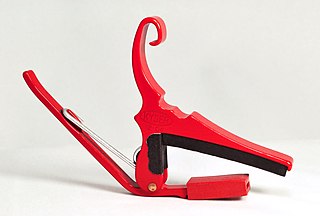
A capo is a device a musician uses on the neck of a stringed instrument to transpose and shorten the playable length of the strings—hence raising the pitch. It is a common tool for players of guitars, mandolins, mandolas, banjos, ukuleles and bouzoukis. The word derives from the Italian capotasto, which means the nut of a stringed instrument. The earliest known use of capotasto is by Giovanni Battista Doni who, in his Annotazioni of 1640, uses it to describe the nut of a viola da gamba. The first patented capo was designed by James Ashborn of Wolcottville, Connecticut year 1850.
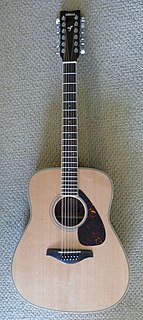
The 12-string guitar is a steel-string guitar with 12 strings in six courses, which produces a thicker, more ringing tone than a standard six-string guitar. Typically, the strings of the lower four courses are tuned in octaves, with those of the upper two courses tuned in unison. The gap between the strings within each dual-string course is narrow, and the strings of each course are fretted and plucked as a single unit. The neck is wider, to accommodate the extra strings, and is similar to the width of a classical guitar neck. The sound, particularly on acoustic instruments, is fuller and more harmonically resonant than six-string instruments.

George Formby,, was an English actor, singer-songwriter and comedian who became known to a worldwide audience through his films of the 1930s and 1940s. On stage, screen and record he sang light, comical songs, usually playing the ukulele or banjolele, and became the UK's highest-paid entertainer.

The Appalachian dulcimer is a fretted string instrument of the zither family, typically with three or four strings, originally played in the Appalachian region of the United States. The body extends the length of the fingerboard, and its fretting is generally diatonic.

The cümbüş is a Turkish stringed instrument of relatively modern origin. It was developed in 1930 by Zeynel Abidin Cümbüş (1881–1947) as an oud-like instrument that could be heard as part of a larger ensemble.
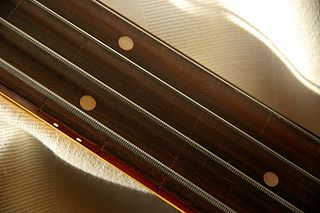
A string is the vibrating element that produces sound in string instruments such as the guitar, harp, piano, and members of the violin family. Strings are lengths of a flexible material that a musical instrument holds under tension so that they can vibrate freely, but controllably. Strings may be "plain", consisting only of a single material, like steel, nylon, or gut, or wound, having a "core" of one material and an overwinding of another. This is to make the string vibrate at the desired pitch, while maintaining a low profile and sufficient flexibility for playability.

The Ukulele Orchestra of Great Britain (UOGB) is an English musical ensemble founded in 1985, consisting entirely of ukuleles of various sizes and registers, accompanied by the natural voices of the performers. The orchestra play and sing music from a variety of musical genres, ranging from pop, rock, and punk to classical tunes, with humour long being a feature of their act. The UOGB has played at many international venues and festivals. They now brand themselves as "George Hinchliffe's Ukulele Orchestra of Great Britain".
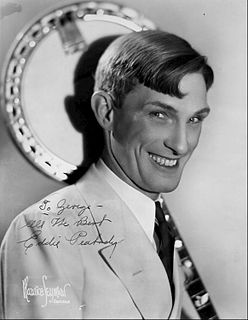
Edwin Ellsworth Peabody, known as Eddie Peabody was an American banjo player, instrument developer and musical entertainer whose career spanned five decades. He was the most famous plectrum banjoist of his era.

The qinqin is a plucked Chinese lute. It was originally manufactured with a wooden body, a slender fretted neck, and three strings.photo 1[ photo 2] Its body can be round,photo hexagonal, or octagonal.[ photo] Often, only two strings were used, as in certain regional silk-and-bamboo ensembles.photo In its hexagonal form, it is also referred to as meihuaqin.

The mandolin-banjo is a hybrid instrument, combining a banjo body with the neck and tuning of a mandolin or violin. It is a soprano banjo. It has been independently invented in more than one country, being called banjolin and banjourine in English-speaking countries, banjoline and bandoline in France, and the Cümbüş in Turkey.
The split stroke is a style of playing the ukulele which is peculiar to the George Formby style of playing. It is a syncopated rhythm where the player will strike all of the strings, and then on the return, catch the first string, and then before starting again hit the last string:

On a stringed instrument, a break in an otherwise ascending order of string pitches is known as a re-entry. A re-entrant tuning, therefore, is a tuning where the strings are not all ordered from the lowest pitch to the highest pitch.

A zero fret is a fret placed at the headstock end of the neck of a banjo, guitar, mandolin, or bass guitar. It serves one of the functions of a nut: holding the strings the correct distance above the other frets on the instrument's fretboard. A separate nut is still required to establish the correct string spacing when a zero fret is used.

The yaylı tambur is a bowed long-neck lute from Turkey. Derived from the older plucked tambur, it has a long, fretted neck and a round metal or wooden soundbox which is often covered on the front with a skin or acrylic head similar to that of a banjo.
Billy "Uke" Scott was a British music hall star, who inspired three generations of ukulele players, composing, singing and writing a "teach-yourself" ukulele manual.
Andy Eastwood is a vaudeville entertainer and ukulele player.
Kelvin Kirkwood Keech was an American actor, producer and old-time radio announcer.
